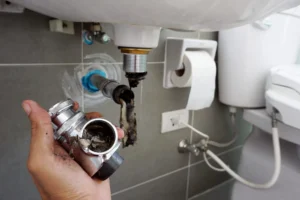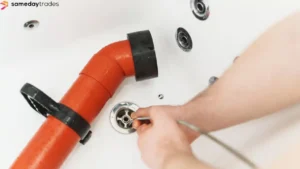Fixing a dead power outlet can feel like a major hassle. Did you know an average home may encounter electrical issues several times in a year? This article brings practical tips to safely tackle those pesky outlets, bringing back the spark to your electrical service.
Stick around; you might just find this illuminating.
Understanding Electrical Work and Safety
Working with electricity needs care and knowledge. Always get a skilled electrician for big jobs to keep safe.
Importance of hiring a licensed electrician
Hiring a licensed electrician is crucial for safety and quality. Electricians with licenses have the right training to handle wiring and electrical problems safely. They know the rules and make sure your home meets them.
This keeps everyone safe from electric shocks or fires. They also do a better job because they’ve learned how to fix things properly.
Using someone without a license might save money at first, but it can cause big problems later. For example, your lights might not work right, or you could have dangerous wiring. If something goes wrong, insurance may not cover the damage if an unlicensed person did the work.
So, it’s smarter to hire a licensed electrician who knows what they’re doing.
Do’s and Don’ts of electrical work
Working with electricity is serious. Always put safety first. Here’s what you should and shouldn’t do:
-Do hire a licensed electrician for major projects. They know how to do the job safely.
-Don’t try fixing things you’re not sure about. It might lead to mistakes.
-Do turn off the power at the main breaker before starting any work. This keeps you safe.
-Don’t use water to put out an electrical fire. It can make things worse.
-Do use the right tools for electrical work, like insulated screwdrivers.
-Don’t overload power outlets with too many devices. It can cause a fire.
-Do check cords for damage before using them. Frayed wires are dangerous.
-Don’t insert metal objects into outlets. It’s a shock hazard.
-Do keep water away from all electrical devices, to avoid shocks.
-Don’t ignore warning signs like flickering lights or buzzing sounds, they mean something’s wrong.
-Do learn how your home’s electrical system works, it helps in emergencies.
-Don’t forget to use a voltage tester to check if wires are live, always check first.
-Do label your circuit breaker switches for quick identification during issues or emergencies.
Quick Fixes for Dead Power Outlets
Sometimes, outlets stop working. You can try simple things to fix them before calling for help.
Replace the outlet
To fix a dead outlet, you might need to replace it. First, buy a new one from the store. Make sure it matches your old one. Back at home, turn off the power for safety. Next, unscrew the faceplate and remove the old outlet carefully.
Disconnect wires from the old outlet and connect them to the new one just like they were before.
Tighten screws to hold wires in place on the new outlet; push it back into the wall box. Screw on a new faceplate if you got one, then turn power back on to test it out. You’ve done it! Keep tools handy for future fixes too.
Check for loose or damaged wiring
Checking for loose or damaged wiring is a key step. First, turn off the power to ensure safety. Next, remove the cover plate and inspect all wires inside. Look closely for any that are loose or look worn out.
If you find any, tighten them with a screwdriver or replace them if they’re badly damaged. It’s important to make sure everything is secure and in good condition before turning the electricity back on.
Loose connections can cause an outlet to stop working or become a fire hazard. Making sure wires are tightly connected can solve some problems without needing more repairs. Always be careful and call a professional if you’re not sure what to do.
Fixing electrical issues safely keeps your home running smoothly.
Unplug and plug back in
Sometimes, fixing a dead power outlet can be as simple as unplugging and then plugging your device back in. This step might seem too easy, but it actually helps. It resets the connection between your device and the power source.
Make sure to do it carefully. Pull the plug out gently, wait a few seconds, then plug it back into the outlet firmly.
Giving this method a try solves minor problems that stop electricity from flowing properly. It’s like hitting a refresh button for your outlet. Always use caution and make sure everything you handle is safe to touch with bare hands.
Reset the circuit breaker
Find your home’s electrical panel. Look for a switch that is either off or not fully on. Flip it back to the “on” position. This can bring your outlet back to life.
If flipping doesn’t work, push any button labeled “reset” on the breaker itself. This action often fixes power issues with outlets, allowing electricity to flow again.
Use a power strip
Using a power strip can be a smart fix for dead power outlets. It lets you plug in multiple devices at once. Make sure to pick one with surge protection. This keeps your gadgets safe from sudden spikes in electricity.
Place the power strip near your device area for easy reach.
Always check that the power strip handles the right amount of electricity for what you plug in. Keep it away from water and don’t overload it with too many devices. This helps avoid fires or damage to your electronics.
How to Safely Replace an Electrical Outlet
To safely replace an electrical outlet, first make sure to switch off the power. Then, carefully take out the old outlet and get ready to put in a new one.
Turn off the power
Make sure the power is off before you start. Go to your circuit breaker or fuse box and flip the switch for the area where you’re working. This stops electricity from reaching the outlet, keeping you safe.
Use a voltage tester on the outlet afterwards. This checks if it’s really off. You don’t want any surprises.
Keep this rule every time: safety first, always turn off the power at your main panel first. This simple step protects you from shock and makes fixing an electrical outlet safer. It’s all about being careful and making sure we stay safe while we work on electrical stuff.
Remove the wall plate
Once you’ve turned off the power, it’s safe to move on to the next step. You’ll need a screwdriver for this part. Use it to unscrew and gently remove the wall plate that covers the outlet.
Be careful not to yank or pull too hard; you don’t want to damage any wires behind it.
With the wall plate off, take a look at what’s inside. You’ll see wires and screws. This is where you need to be cautious. Make sure nothing is loose before you proceed further with fixing or replacing the outlet.
Double check wires for power
After removing the wall plate, your next step is making sure there’s no power flowing through the wires. Use a voltage tester on each wire. Touch the device to the wires carefully.
If it lights up or beeps, there’s still electricity in them. You’ll need to double-check your circuit breaker and make sure you turned off the right one.
Checking for power is crucial before going further. It keeps you safe from shocks. Always use a reliable voltage tester for this task. This way, you ensure that all electricity is off in those wires before touching them or proceeding with any work.
Safety first – never skip this step!
Determine the correct receptacle size
To pick the right size for your electrical outlet, you first need to check what you currently have. Outlets come in different shapes and sizes. Most homes use standard outlets which are perfect for everyday gadgets and appliances.
But if you’re using something that needs more power, like a big fridge or washing machine, you might need a larger one with more slots.
Take a look at the label on your existing outlet or measure it. This will tell you if it’s a 15-amp or 20-amp receptacle. The number tells how much electricity can go through safely without tripping.
If all this seems confusing, no worries—a quick chat with someone at your local hardware store can clear things up. They’ll help match the right size and type for your needs, ensuring everything stays safe and works well.
Install the new receptacle
First, gently push the wires back into the box. Make sure you don’t force them too much. Next, line up your new receptacle with the mounting brackets inside the box. Screw it in place, but keep it snug—not too tight.
Attach the wall plate over it. This part is easy and gives everything a neat finish.
Now, turn the power back on at your circuit breaker. Test your outlet with a small appliance to check if it works right. Done this way, fixing an electrical outlet can be straightforward and safe.
Tips and Resources for Fixing Electrical Outlets
For those keen on DIY, a good guide can make fixing electrical outlets much easier. Look for tutorials with clear steps, and don’t forget to grab the right tools before you start.
Recommended materials and tools
Fixing an electrical outlet requires the right materials and tools. Having these on hand makes the job safer and easier to complete.
Voltage tester: This tool helps you make sure power is off before you start working.
Screwdrivers: You need both flathead and Phillips head screwdrivers to remove and secure screws.
Wire strippers: These are used to cut and remove insulation from wires safely.
Needle-nose pliers: Useful for bending wires and holding small parts.
Electrical tape: Wraps around wires for insulation after making connections.
Outlet receptacle: Choose the correct size and type for your replacement.
Wall plate: To cover the outlet once you have installed it.
Wire nuts: For securely connecting wire ends together.
Circuit breaker finder: Helps identify the correct circuit breaker for the outlet you’re fixing.
Safety glasses: Protect your eyes from sparks or debris when working on electrical projects.
Torch or headlamp: Provides lighting in dark spaces, making work easier and safer.
Multimeter: Measures voltage, current, and resistance to troubleshoot problems effectively.
With these tools and materials, fixing an electrical outlet can be a straightforward task, ensuring safety and reliability in your home’s electrical system.
Step-by-step instructions
Fixing a dead power outlet can be straightforward if you follow the right steps. Safety is key, so always ensure you’re taking the proper precautions. Here are the step-by-step instructions:
-First, gather all necessary tools and materials. You’ll need a screwdriver, a new electrical outlet, and a voltage tester.
-Next, turn off the power to the outlet from your home’s fuse box to prevent electric shock.
-Use the voltage tester on the outlet to double-check that there is no power running to it.
-Unscrew the wall plate and remove it, then pull out the outlet from the wall carefully.
-Check for any loose or damaged wires and tighten any loose connections with your screwdriver.
-If wires are damaged, cut away the damaged portion and strip some insulation off the ends of wires to prepare them for reconnection.
-Connect wires to your new outlet—black wire to brass screw, white wire to silver screw, and green or bare wire to green screw for grounding.
-Carefully push the outlet back into the wall box and secure it with screws.
-Reattach the wall plate over your newly installed outlet.
-Turn on power at your fuse box again.
-Test your new outlet with a small appliance or lamp to ensure everything works correctly.
Moving on, let’s look into what tools and materials you should always have at hand for such repairs…
Additional safety tips
Fixing an electrical outlet safely is crucial. Always prioritise your safety and follow these extra tips.
-Always use insulated tools to protect yourself from electric shocks.
-Wear rubber-soled shoes for added insulation when working with electricity.
-Keep a torch handy in case the power goes out or you need additional light.
-Make sure your hands are dry before touching any electrical components to avoid electric shocks.
-Use a voltage tester on the outlet before and after fixing it to ensure it’s safe.
-Follow the manufacturer’s instructions for any new parts you install.
-Keep all flammable materials away from your working area to prevent fires.
-Don’t work alone; have someone nearby in case of an emergency.
-Ensure all metal objects like jewellery and watches are removed to prevent accidental conduction.
-Double-check everything is off at the breaker box before starting your work, not just relying on wall switches.
-Return all tools and materials to their proper place after finishing, to keep your workspace organised and safe for next time.
Common mistakes to avoid
After looking into additional safety tips, we move on to common mistakes to avoid. Fixing an electrical outlet seems straightforward but can go wrong quickly. Here are errors many people make:
-Skipping the step to turn off the power at the main switchboard. This is crucial for safety.
-Not testing the outlet with a voltage tester before starting work. This confirms if the power is truly off.
-Using incorrect tools that aren’t insulated, putting you at risk of electric shock.
-Forgetting to check wire connections are tight and secure in the new outlet.
-Installing the outlet without matching it to the wire size or type used in your home can cause issues.
-Overlooking damaged insulation on wires which can lead to short circuits or fires.
-Failing to properly earth the outlet, essential for preventing electric shocks.
-Ignoring local codes and regulations about electrical installations may get you into legal trouble.
-Choosing a cheap, low-quality receptacle that won’t last or perform well over time.
-Attempting complex repairs you’re not qualified for instead of calling a licensed electrician when necessary.
Avoiding these mistakes ensures a safer and more reliable fix for any dead power outlets in your home.
How to find professional help if needed
Finding a good electrician can be easier than you think. You might start by asking friends or family for recommendations. People love to share when they’ve found someone great. Online reviews can also guide you in the right direction.
Look for electricians with high ratings and positive comments about their work.
Another way is to check local business directories or online trade websites. These places list qualified professionals near you. Make sure whoever you choose has the proper license and insurance.
This keeps everything safe and above board.
Conclusion
Fixing an electrical outlet might seem like a big task, but you can do it with the right tools and knowledge. Keep safety first—always turn off the power before you start. Replacing or repairing your outlet can be quick if you follow steps correctly.
Don’t forget to double-check for any loose wires. And always call a professional if things look too tricky. With these tips, fixing that dodgy outlet is more doable than ever!










